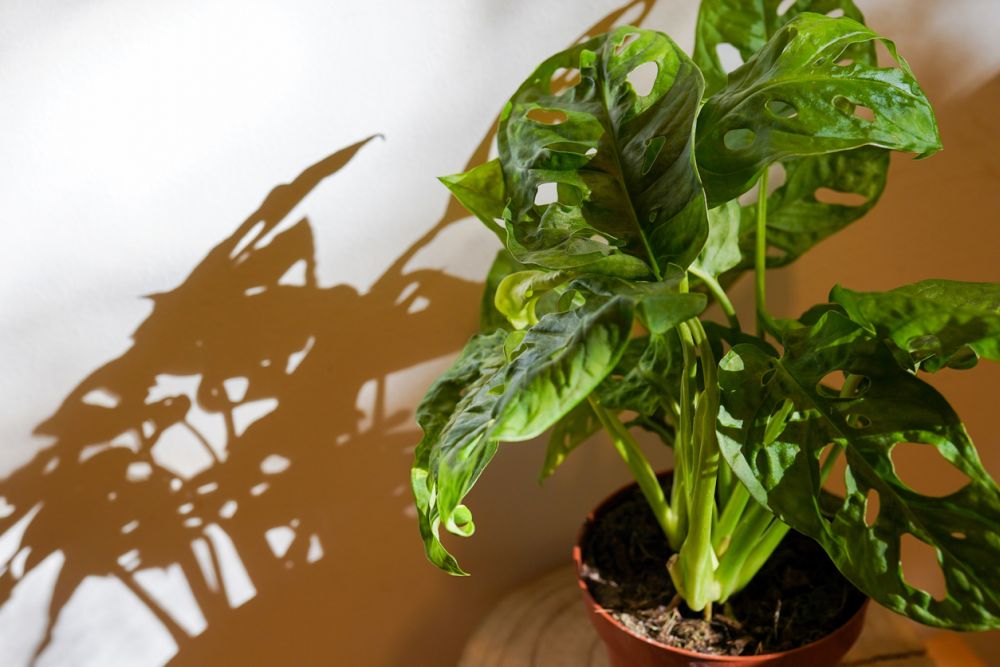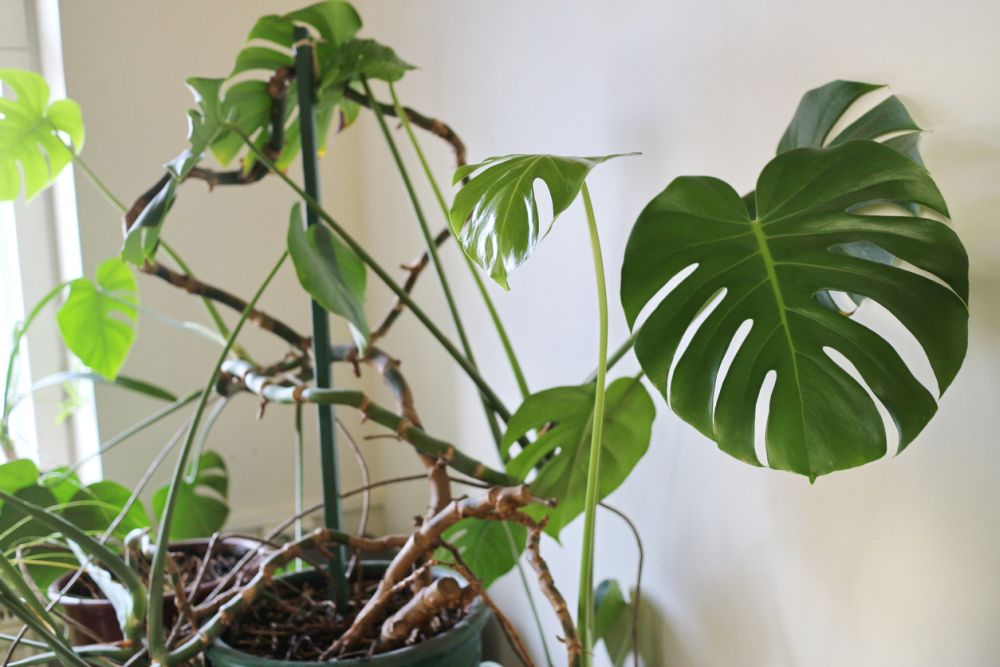Repotting a large plant is more time-consuming than transferring a small houseplant to a new container. Read on to discover how to transfer a big plant to a new pot without killing it.

Given the large size, maneuvering a big houseplant is quite challenging since you must move it from one room to another. It’s also heavy, so it’s best to ask someone for help. Nevertheless, with the proper preparation, repotting a large plant should be a breeze.
This article describes the signs that your large plant must be repotted soon, the supplies and step-by-step instructions necessary for transferring a big houseplant to a new container, and additional information.
When should larger plants be repotted?
Here are signs that your large plant must be repotted soon:
- Slowed growth cycle: The growth rate of a large plant may be difficult to observe due to its size. If you don’t notice any signs of growth, the plant’s root system is likely starving for nutrients, so it needs new potting soil.
- Yellow foliage: Many plants have a yearly cycle where the leaves become yellow and fall off during a certain season. However, if your plant’s foliage is turning yellow and no signs indicate regrowth, it’s time to repot it.
- Visible root growth: Usually, plants need repotting because their roots have outgrown their containers. If your plant’s roots are poking out of the drainage holes or pushing the whole plant out of the container, it’s time to repot it.
- Needs more watering: When watering the plant, check if the soil quickly absorbs the water. It could indicate that the plant needs fresh soil to provide a constant water supply.
- The plant is top-heavy: If the houseplant is lopsided, it could mean it needs repotting.
- Uneven potting mix: Potting mix moving away from the edges of the pot indicates that the plant has absorbed all nutrients, drawing it closer to its root system and forming what looks like a small mound around the plant.
Supplies for repotting a large plant
- Gardening gloves to handle large, woody houseplants with thorns on their stems and leaves.
- Cardboard sheets to wrap around the stems of the plants. Use these sheets only if you don’t have gardening gloves.
- Pruners or gardening shears to trim the root system of the large plant.
- A new pot larger than the old one, depending on how badly the old plant needed a repotting. Use a pot twice as big as the current one if the plant is root-bound.
- A container for mixing water with potting soil, like a bucket or a wheelbarrow.
- to fill the new container. Check the soil preferences of your plant to see which potting mix works best. Typically, it contains peat moss, vermiculite, and perlite.
- Fertilizers or soil amendments to get the plant back on track if its repotting is overdue.
- A trowel or a small metal skewer to separate the compacted soil from the pot edges.
- Porous material for containers without drainage holes, such as pea gravel, small stones, or broken clay pots.
- A watering can or a water bottle to thoroughly water the plant after relocating it.
- Old newspapers to place on the ground to prevent making a mess while transferring the plants.
How do I repot a large plant?

Follow these instructions to repot a big plant safely:
- Prepare the plant for removal: Water the plant thoroughly a couple of days before repotting it. It will moisten and loosen up the soil, simplifying the job of removing the plant from its current pot.
- Prepare the new pot (optional): Mix potting soil with an equal part of water in a large container to help moisturize the large plant after repotting it. Fill about a third of the new pot with the potting mix mixture, distributing it evenly. If the pot doesn’t have drainage holes, add a layer of porous material to the bottom.
- Remove the large plant from the current pot: Check if the plant’s roots have grown through the drainage holes. If so, you will have to cut the roots enough to release the plant from its pot. Turn the big houseplant on its side, grab it by the base of the stem, and give it a few gentle tugs to help it slide out. If it doesn’t work, run a trowel along the pot edges to dislodge some compacted soil from the sides. If the pot is plastic, consider cutting it to free the plant.
- Remove the old potting mix: Use your hands to remove any excess solid clinging to the root ball. This step is important since the old soil has no nutrients left and likely contains dangerous salts accumulated over time.
- Loosen and trim the roots: Use trimmers or shears to remove sick, damaged, or dead roots. Trimming is also helpful for controlling the plant’s growth patterns.
- Add the big plant to the new pot: Place the large houseplant in the new container on top of the soil added earlier. Secure the plant with one hand to ensure it stays upright while adding more moist soil mix. Continue adding soil until covering the rootball, gently compacting it from time to time. Leave about 1 inch (2.5 cm) between the topsoil and the pot rim.
- Even out the soil: Use your hands or a trowel to compact and even out the topsoil gently. This will ensure that there are no large air bubbles in the soil. Compacting the soil too hard will cause the plant to suffocate.
- Fertilize the large plant (optional): Give the large, freshly repotted plant a nutrient boost and help it recover faster using a fertilizer. This step is also recommended if the potting mix isn’t ideal for the plant.
- Water the large plant: Thoroughly water the repotted plant, especially if you didn’t mix the potting soil with water. Otherwise, water the plant as usual.
After repotting your large plant, keep it out of direct sunlight for at least two weeks.
FAQs
Check out more helpful information about repotting large plants:
What are alternatives to repotting a large plant?
Changing the topsoil or trimming the roots are good alternatives to repotting a large plant since it’s easier to make these adjustments. Changing the topsoil is a good alternative to postpone the repotting of a large plant for up to a year. But it won’t work if the plant’s root system has outgrown the pot. In that case, repotting is mandatory. To change the topsoil, loosen up the top third layer of the potting mix, remove it, and put a fresh batch of soil in its place. Then thoroughly water the soil and fertilize the plant to boost it. Trimming the roots affects the plant’s growth, which is why many people use this technique to prevent a houseplant from getting too large. A plant’s aerial part is roughly the same size as its root system, and trimming the roots more will prevent the plant from growing.
How do you repot a large plant without killing it?
The secret to repotting any plant safely is to handle the roots gently. Any damage sustained by the roots will directly impact the plant. So, take care when loosening the soil off the rootball or trimming the roots.
How big is too big for repotting?
When repotting a plant, choose a new pot with a diameter of 1-2 inches (2.5-5 centimeters) larger than the current pot to .
How do you repot an outgrown plant?
Outgrown plants are root-bound, which means that their roots are poking out of the drainage holes or pushing the plant out of its pot. Repotting an outgrown plant requires extra care not to destroy the rootball. It’s necessary to cut the roots just enough to release the plant from its pot, but this also means removing part of the foliage to ensure the new root system will support the plant.
Closing thoughts
Repotting a large plant is not that different from . Follow the steps outlined above, and with patience, you will successfully repot your favorite plants without killing them in the process.
The post appeared first on .





























